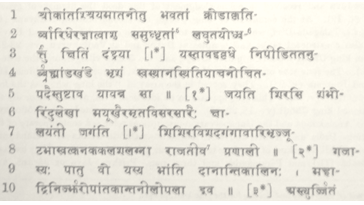|
The Indian Analyst
|
North Indian Inscriptions |
GANAPESVARAM INSCRIPTION OF GANAPATI. Nârâyaṇa (II.) (v. 32). At this time (the Kâkatîya) king Gaṇgapati, who had defeated the kings of Chôḷa, Kaliṅga, Sêvaṇa,1 Karṇâṭa, and Laṭâ, conquered the country of Velanâṇḍu, together with Dvîpa (v. 34). Having taken to wife Nârama and Pêrama (i.e. Nârâmbâ II. and Pêramâmbâ of verse 32), he took their younger brother Jâya or Jâyana into his service (v. 36 f.) and appointed him general (v. 38). Jâya had, on a previous occasion, defeated a certain Vairigôdhûmagharaṭṭa (v. 41). ......The immediate object of the inscription is to record that the general Jâya built at Dvîpa a temple of Śiva, which he called Gaṇapêśvara or Gaṇapatîśvara in honour of his patron, king Gaṇapati (v. 44 f.), and the name of which survives to the present day in the hamlet of Gaṇapêśvaram. The date of the consecration of the temple was the tithi of Gaurî in the bright fortnight of Vaiśâkha of the Śaka year 1153, which corresponded to the cyclic year Khara (v. 45). I am obliged to Mr. Dikshit for the following remarks on his date :─ ......“The goddess Gaurî is supposed to have been born on the fourth tithi of Jyaishṭha, but is considered as the regent of the third tithi. Consequently, the “tithi of Gaurî” might be meant for the third or fourth tithi. Observances on honour of Gaurî are enjoined on both the third and the fourth tithi of some of the twelve months. One of these observances commences on the Chaitra śukla tṛtîyâ and ends on the Vaiśâkha śukla tṛitîyâ. This tithi ended in Śaka- Saṁvat 1153 expired, the Khara saṁvatsara, on Monday, the 7th April, A.D. 1231, at 11 gh. 10 p., and Vaiśâka śukla chaturthî ended on Tuesday, the 8th April, at 7 gh. 13 p. Ujjain mean-time.” ......The Telugu portion of the inscription (lines 121 to 135)2 records that certain dues had to be paid by every boat touching at Naṅgegaḍḍa to the temple of Gaṇapaṭîśvara at Divi,3 and that Jâyapa-Nâyaka (i.e. Jâyana of the Sanskṛit portion) assigned the revenue of a number of villages to the same temple, and granted twenty-five cows, the milk of which was to be used for supplying ghee to a perpetual lamp.
TEXT.4
......1 See Ind. Ant. Vol. XXI. p. 199 f.
| ||||||||||||||||||||||||||||||||||||||||||||||||||||||||||||||||||||||||||||
| > |
|
>
|








